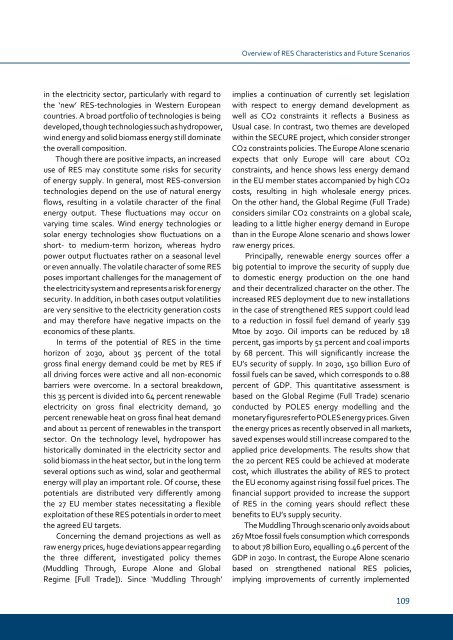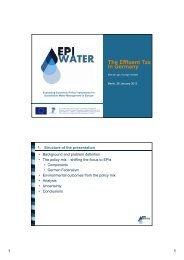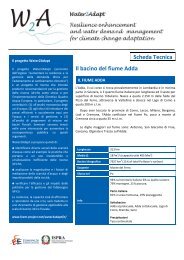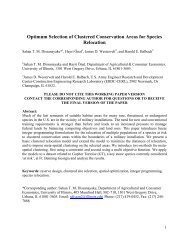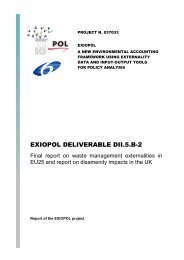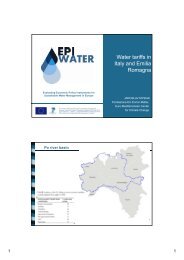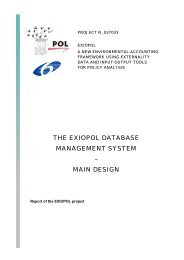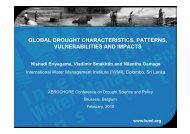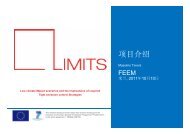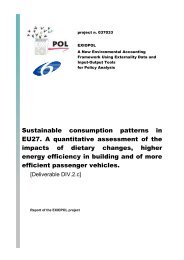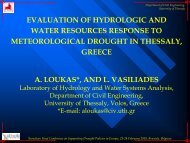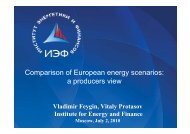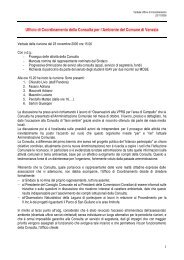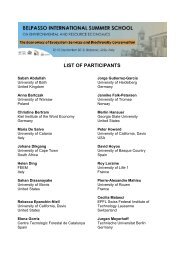Gulf and European Energy Supply Security - Feem-project.net
Gulf and European Energy Supply Security - Feem-project.net
Gulf and European Energy Supply Security - Feem-project.net
Create successful ePaper yourself
Turn your PDF publications into a flip-book with our unique Google optimized e-Paper software.
in the electricity sector, particularly with regard to<br />
the ‘new’ RES-technologies in Western <strong>European</strong><br />
countries. A broad portfolio of technologies is being<br />
developed, though technologies such as hydropower,<br />
wind energy <strong>and</strong> solid biomass energy still dominate<br />
the overall composition.<br />
Though there are positive impacts, an increased<br />
use of RES may constitute some risks for security<br />
of energy supply. In general, most RES-conversion<br />
technologies depend on the use of natural energy<br />
flows, resulting in a volatile character of the final<br />
energy output. These fluctuations may occur on<br />
varying time scales. Wind energy technologies or<br />
solar energy technologies show fluctuations on a<br />
short- to medium-term horizon, whereas hydro<br />
power output fluctuates rather on a seasonal level<br />
or even annually. The volatile character of some RES<br />
poses important challenges for the management of<br />
the electricity system <strong>and</strong> represents a risk for energy<br />
security. In addition, in both cases output volatilities<br />
are very sensitive to the electricity generation costs<br />
<strong>and</strong> may therefore have negative impacts on the<br />
economics of these plants.<br />
In terms of the potential of RES in the time<br />
horizon of 2030, about 35 percent of the total<br />
gross final energy dem<strong>and</strong> could be met by RES if<br />
all driving forces were active <strong>and</strong> all non-economic<br />
barriers were overcome. In a sectoral breakdown,<br />
this 35 percent is divided into 64 percent renewable<br />
electricity on gross final electricity dem<strong>and</strong>, 30<br />
percent renewable heat on gross final heat dem<strong>and</strong><br />
<strong>and</strong> about 11 percent of renewables in the transport<br />
sector. On the technology level, hydropower has<br />
historically dominated in the electricity sector <strong>and</strong><br />
solid biomass in the heat sector, but in the long term<br />
several options such as wind, solar <strong>and</strong> geothermal<br />
energy will play an important role. Of course, these<br />
potentials are distributed very differently among<br />
the 27 EU member states necessitating a flexible<br />
exploitation of these RES potentials in order to meet<br />
the agreed EU targets.<br />
Concerning the dem<strong>and</strong> <strong>project</strong>ions as well as<br />
raw energy prices, huge deviations appear regarding<br />
the three different, investigated policy themes<br />
(Muddling Through, Europe Alone <strong>and</strong> Global<br />
Regime [Full Trade]). Since ‘Muddling Through’<br />
Overview of RES Characteristics <strong>and</strong> Future Scenarios<br />
implies a continuation of currently set legislation<br />
with respect to energy dem<strong>and</strong> development as<br />
well as CO2 constraints it reflects a Business as<br />
Usual case. In contrast, two themes are developed<br />
within the SECURE <strong>project</strong>, which consider stronger<br />
CO2 constraints policies. The Europe Alone scenario<br />
expects that only Europe will care about CO2<br />
constraints, <strong>and</strong> hence shows less energy dem<strong>and</strong><br />
in the EU member states accompanied by high CO2<br />
costs, resulting in high wholesale energy prices.<br />
On the other h<strong>and</strong>, the Global Regime (Full Trade)<br />
considers similar CO2 constraints on a global scale,<br />
leading to a little higher energy dem<strong>and</strong> in Europe<br />
than in the Europe Alone scenario <strong>and</strong> shows lower<br />
raw energy prices.<br />
Principally, renewable energy sources offer a<br />
big potential to improve the security of supply due<br />
to domestic energy production on the one h<strong>and</strong><br />
<strong>and</strong> their decentralized character on the other. The<br />
increased RES deployment due to new installations<br />
in the case of strengthened RES support could lead<br />
to a reduction in fossil fuel dem<strong>and</strong> of yearly 539<br />
Mtoe by 2030. Oil imports can be reduced by 18<br />
percent, gas imports by 51 percent <strong>and</strong> coal imports<br />
by 68 percent. This will significantly increase the<br />
EU’s security of supply. In 2030, 150 billion Euro of<br />
fossil fuels can be saved, which corresponds to 0.88<br />
percent of GDP. This quantitative assessment is<br />
based on the Global Regime (Full Trade) scenario<br />
conducted by POLES energy modelling <strong>and</strong> the<br />
mo<strong>net</strong>ary figures refer to POLES energy prices. Given<br />
the energy prices as recently observed in all markets,<br />
saved expenses would still increase compared to the<br />
applied price developments. The results show that<br />
the 20 percent RES could be achieved at moderate<br />
cost, which illustrates the ability of RES to protect<br />
the EU economy against rising fossil fuel prices. The<br />
financial support provided to increase the support<br />
of RES in the coming years should reflect these<br />
benefits to EU’s supply security.<br />
The Muddling Through scenario only avoids about<br />
267 Mtoe fossil fuels consumption which corresponds<br />
to about 78 billion Euro, equalling 0.46 percent of the<br />
GDP in 2030. In contrast, the Europe Alone scenario<br />
based on strengthened national RES policies,<br />
implying improvements of currently implemented<br />
10


